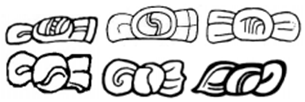![]()

![]()

K&H.p82.#6 TOK.p12.r3.c3 JM.p125.#5 25EMC.pdfp35.#4.2 = K&L.p28.#1.3
HUN HUUN


K&L.p28.#1 BMM9.p11.r7.c3
HUN HUN
![]()
![]()
![]()
K&H.p82.#7 TOK.p7.r5.c4 JM.p125.#3 = K&L.p28.#2.6 = 25EMC.pdfp35.#4.3
HUN HUUN HUN

![]()
![]()
K&L.p28.#2 = KuppratApp BMM9.p10.r3.c2 25EMC.pdfp35.#4.4
HUN / HU’N HUN
![]()
HUUN
Jackson&Stuart-AKT.p219.fig3.e


![]()
K&L.p28.#4.1&2&3 TOK.p27.r1.c3 25EMC.pdfp35.#4.8-9 25EMC.pdfp35.#4.10&11 = K&L.p28.#4.1&2
HUN HUUN HUN



![]()
MHD.SM1.1&2 1558st T1030o
HU’N HUUN -

![]()
![]()
Schele Schele Looper
PAL TI CT E2 PAL TI CT J2 QRG Stela E D5b
*SAK.<HUUN:na> SAK.<HUUN:na> TI’:HUUN[?]


Graham Coll-1
YAX Lintel 38 A3 YAX Lintel 10 B1b
5.<HUUN:na> TI’:HUUN:na

BMM9.p13.r6.c4
HUN


TOK.p14.r2.c1 = BMM9.p11.r7.c2 25EMC.pdfp35.#4.5-7
HUUN

IC.p22
<SAK.HUUN>:K’AL>
tu.<u:BAAH>
· No glyphs given (head variant) in K&H, BMM9.
· This logogram has the concrete meanings “book”, “paper”, “headband”, “headdress” (all made from the precious material “paper”). But it also can occur in Glyph-F; as Ti’ Huun, the meaning of which is unclear: conventionally explained as “edge of the book or mouth (i.e. priest who performs the ritual)”.
· Variants (5):
o A. Book: the iconography is based on the pages of book, enclosed in two jaguar-skin covers. This logogram often means book, but there is a monument in a quite unknown site with only one stela – Tila – where it means something else: u-huun-na (book); see mail of 27 March 2021, the other HUUN is actually TI’ (because we know that this is in the context of Glyph-F). So other instances for K’ahk’ Uti Witz’ K’awiil, we have some “HUUN” which we can also read as TI’.
o B. Knot: a loop at one end, (two) tassels on the other, with a knot in the middle.
o C. Deity head: often with a LEM in the middle of the top of the head, a large square eye, and a tendril leaving the right of the mouth, going downwards then to the right.
§ MHD describes it from an iconographic point of view as: deity with shiny markings, leaves, and square eye. It also labels it as the “Jester God”.
§ QRG Stela E D5b seems to have a right-side-up “la-face” infixed in the centre of the head, where the LEM normally is (obscuring the LEM).
o D. Human head:
§ BMM9.p13.r1.c4 is the only known human head variant seen so far – it lacks the “LEM” in the top of the head, which is present in many other examples of the bird head variant – there are no real distinguishing characteristics, and the reading has to be made from context.
§ I distinguish it from the deity head because the deity head is rather “bird-like”, whereas this variant is very “human”.
o E. WINIK-like, but subject to a very wide degree of variation.
§ Distinctive characteristic: triangular element with left and right sides slightly curved inwards, tip pointing upwards, at the centre of the bottom. This can help to distinguish it from WINIK, which generally has a “YAX-outline” element at that spot.
§ 25EMC.pdfp35.#4.5 does not have this element and has instead the “YAX-outline” – perhaps a mistake, as this is normally WINIK, or the diagnostic separating them is not as strict as it could be.
· “NUUN” vs. HUUN. There is sometimes a misconception that the knot variant of HUUN can also be read as NUUN. This arises perhaps because of the Tikal ruler by the name of Yax Nuun Ahiin. In his name, there is a YAX on the left and an AHIIN as the main glyph, with a “knot” above. However, the NUUN in this ruler’s name is not the same glyph as the knot variant of HUUN. Instead, there is a logogram NUUN, which is the head of a man, with (optional) initial and final phonetic complement of nu. The AHIIN then gets infixed in the NUUN, obscuring the head of the man, and just leaving the initial and final phonetic complements, i.e. the “knot” at the top.
|
|
|
|
|
|
nu MC.p159.r5.c1.6 H&S.p33.r1.c5.4 |
NUUN (without and with phonetic complements) |
Yax Nuun Ahiin |
JM.p188.#2
|
· Another possible reason for the misconception is that JM has (in the paper edition) JM.p188.#2 a glyph that is clearly a “knot” given with the pronunciation NUUN. This however has been removed from the online version, perhaps because it doesn’t have such a reading but is just HUUN. The glyph of the human head with a “mo syllabogram” in his mouth is the main sign in the RAZ EG. The connection between the variant of syllabogram nu (MC.p159.r5.c1.6), the knot above the head in the RAZ EG, the knot in Yax Nuun Ahiin’s name, and the knot in JM.p188.#2 is very unclear to me. Recheck with Dorota. Check with Christophe: ask why none of the later syllabogram tables list this form of nu – only MC and H&S, both rather old; furthermore, TOK.p9.r3.c2 seems to have decided it (or something similar) is a logogram.

![]()
JM.p126.#2 Schele
PAL TI CT F4
hu:na u.<K’AL:<hu:na>>
 or
or 